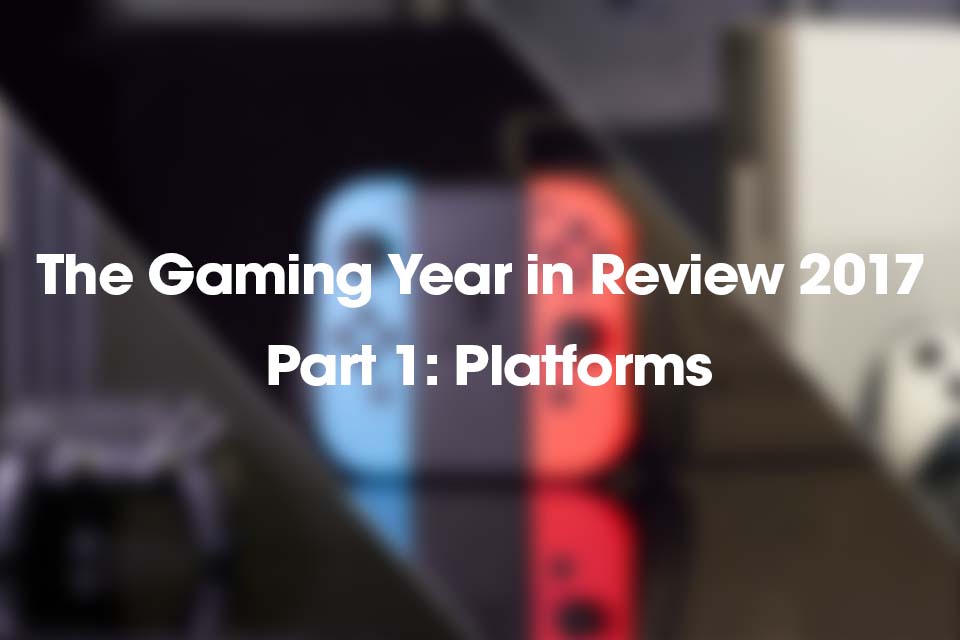
The video game industry grew again in 2017, and fueling this growth was another great year for gamers, game-makers and the curious public. In this two-part look at 2017 in gaming, I’ll focus on the noteworthy and the notorious from the past year.
Once an exclusive domain of special hardware or arcade machines, video games have become prevalent across easy-to-access platforms. At the same time, new avenues of gaming opportunity continue to pop up while competitive gaming grows in popularity. For part one, I’ll look at the platforms we use to play – and watch.
Consoles
“Console wars” will never go away – there will always be two or three companies going head-to-head with their home video game consoles. However, the Sega-Nintendo battles from the ‘80s and 90’s has been replaced with Sony-Microsoft-Nintendo of today. While the competition isn’t as heated as it may have been in those days, there’s plenty of choice for potential gamers among the three major consoles. The best-selling and perhaps best-known of the three is Sony’s PlayStation 4. In 2017, Sony focused on console exclusive titles to support system sales while also continuing to push their PS4 Pro, an enhanced version of the console released in late 2016. Microsoft joined the “enhanced version” bandwagon with their own Xbox One X, calling it the “most power console on Earth,” despite the fact that it plays the same games its less powerful sibling the Xbox One S can play, albeit with better graphics and processing power. Along with releasing the new enhanced console, Microsoft also touted the notion of every Xbox One game being also playable on a Windows computer – talk about corporate synergy!
The newest console player this year is Nintendo’s Switch. Released in March, the Switch has been the biggest video game story of the year, selling 10 million consoles in 9 months. The hybrid console allows you to play at home or on-the-go (with a quick switch – get it?) and will likely outsell its predecessor, Nintendo’s ill-fated Wii U, in one year of release (the Wii U sold only 13.5 million units in four years)! In 2018, look for Switch to be the console king with the most interesting exclusive titles, growing love from independent game developers and even some fascinating releases you’d never expect on a Nintendo console.
PC Gaming
While consoles have a 4-7 year lifespan on similar hardware, PCs are constantly upgradable – which means PC gaming has a lot of potential to grow, but also could leave people behind. In 2017, the most popular kind of PC game remained MOBAs, which are “Multiplayer Online Battle Arenas,” pitting players against each other in real-time in games like Dota 2 and League of Legends. Online multiplayer is still one of the biggest elements of PC gaming, with newer game styles (PlayerUnkonwn’s Battlegrounds brought the “Battle Royale” format to the forefront of gaming) becoming more and more prevalent. The challenge with new games and new ideas is that better hardware is sometimes needed to make it work. My own laptop is 4 years old and has essentially aged out of many modern games, barely struggling to even play Civilization VI (yes, that classic strategy game from the early ‘90s is still around). In 2018, look for the continued domination of PC games focused on online multiplayer experiences, as well as enhanced visuals and playability (when gamers can afford better hardware).
Virtual Reality
At a certain point, we’ll need to stop saying the Virtual Reality (VR) gaming is “new.” While the major platforms in VR (Oculus Rift, HTC Vive and PlayStation VR) only released in 2016, concepts have been developing for many years before that, including limited smartphone-based VR. 2017 saw a growth in unique experiences for VR gamers (including Skyrim VR), but several limitations keep VR from becoming more mainstream, including copious amounts of wires, necessary physical gaming space and especially the cost. In fact, VR gaming is still considered an investment; most VR platforms cost around $500 on their own, and you need either a really good computer ($1500+) or a PlayStation 4 ($300+ for PSVR) before you can even use them. In 2018, look for the next generation of VR including wireless and no-computer-required platforms, along with the new “Windows-certified” VR and augmented reality (AR) headsets designed for everyday computers and gamers.
Mobile
Gaming on smartphones still seems like a foreign concept to most people – especially since all I ever see on the subway is people still playing Candy Crush Saga or one of its homogenous sequels. That said, mobile gaming is a massive industry on its own. 2017 saw some major releases, including new Nintendo titles Fire Emblem Heroes and Animal Crossing Pocket Camp joining last year’s Super Mario Run – all part of Nintendo’s strategy of finally embracing mobile as a meaningful platform for on-the-go gaming. Along with high quality mobile-only games like Monument Valley 2 and Dandy Dungeon, more and more PC and console titles have been ported to ever-more-powerful smartphones from Android developers and Apple. In 2018, look for the lines between PC and mobile gaming to blur as more online multiplayer titles make their way to smartphones – just hope you have a good data plan for those long battles ahead!
eSports
Online multiplayer games bring out some of the best gamers, honing their skills in a specific title. This has led to the steady rise of eSports, which is competitive gaming organized around team and league structures. Throughout 2017, more and more tournaments have been added with new games and gamers filling arenas around the world. Teams vied for a multi-million dollar prize pool in the Dota 2 International and the Overwatch League got started with sports-like city teams (such as the Boston Uprising) beginning their efforts toward domination in the first-person shooter. Driving these competitions is a growing viewer base using platforms like Twitch and YouTube to spectate and speculate about who will win matches. While eSports may seem inaccessible, watching a past match or two in a game you’re interested in could show you new mechanics to try out, or you might want to get competitive yourself. In 2018, look for eSports to go even more mainstream with more televised competitions, bigger prize pools, and more popular awareness thanks to celebrity backing and big-name events.
Stay tuned for part two, where I’ll dive into the most important of video gaming this and any year: the games!

